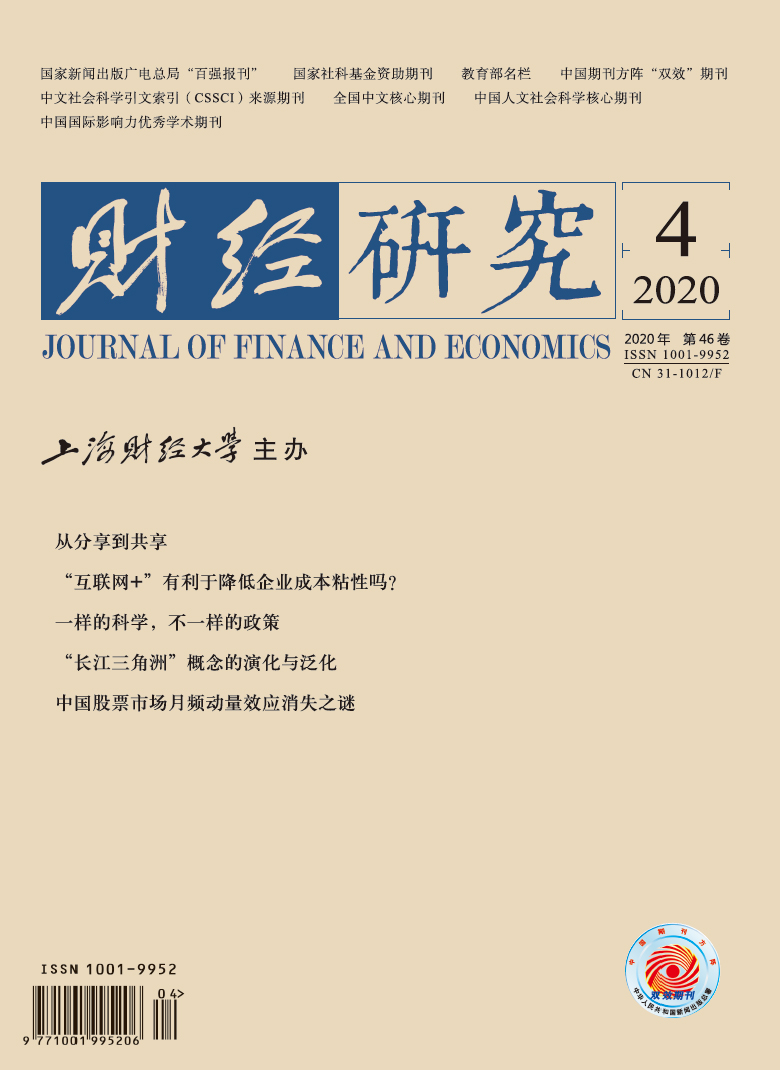[1] Chen K T, Gong L T. Growth and fluctuations in China economy[J]. China Economic Quarterly, 2004, (4): 803-818. (In Chinese)
[2] Jian Z, Zhang T, Fu Y L. Import liberalization, competition and firm’s TFP: China’s accession to the WTO as a natural experiment[J]. Economic Research Journal, 2014, (8): 120-132. (In Chinese)
[3] Li X P, Dai Z H, Peng S Z. Does export sophistication influence firms’ output fluctuation: Evidences from Chinese manufacturing enterprises[J]. Journal of International Trade, 2018, (11): 49-62. (In Chinese)
[4] Mao Q L, Sheng B. Trade liberalization, heterogeneity and firm dynamics: Empirical study based on Chinese manufacturing firms[J]. Journal of Management Word, 2013, (3): 48-68. (In Chinese)
[5] Sheng B, Mao Q L. Does import trade liberalization affect Chinese manufacturing export technological sophistication?[J]. The Journal of World Economy, 2017, (12): 54-77. (In Chinese)
[6] Sun P Y, Zhang Y, Huang J L. Do firms’ exports matter for sales volatility in China? Evidence from firm-level data[J]. The Journal of Financial Research, 2015, (9): 159-173. (In Chinese)
[7] Tian W, Yu M J. Firms’ export intensity and input-import liberalization: Empirical study from Chinese firms[J]. Journal of Management Word, 2013, (1): 36-52. (In Chinese)
[8] Yi J T, Meng S. Trade liberalization, firm heterogeneity and product scope adjustment[J]. The Journal of World Economy, 2015, (11): 76-99. (In Chinese)
[9] Yi X Z, Ouyang Y, Fu X L. Domestic market size and export diversification: The threshold effect of institutional environment[J]. Economic Research Journal, 2014, (6): 18-29. (In Chinese)
[10] Zhou M, Lu Y, Fu D H. Trade liberalization and industrial upgrading in China: Facts and mechanisms[J]. The Journal of World Economy, 2016, (10): 78-102. (In Chinese)
[11] Acemoglu D, Carvalho V M, Ozdaglar A, et al. The network origins of aggregate fluctuations[J]. Econometrica, 2012, 80(5): 1977-2016. DOI:10.3982/ECTA9623
[12] Aiyagari S R, Christiano L J, Eichenbaum M. The output, employment, and interest rate effects of government consumption[J]. Journal of Monetary Economics, 1992, 30(1): 73-86. DOI:10.1016/0304-3932(92)90045-4
[13] Bernard A B, Redding S J, Schott P K. Multiproduct firms and trade liberalization[J]. The Quarterly Journal of Economics, 2011, 126(3): 1271-1318. DOI:10.1093/qje/qjr021
[14] Blanchard O, Simon J. The long and large decline in U.S. output volatility[J]. Brookings Papers on Economic Activity, 2001, 2001(1): 135-174. DOI:10.1353/eca.2001.0013
[15] Brandt L, van Biesebroeck J, Wang L H, et al. WTO accession and performance of Chinese manufacturing firms[J]. American Economic Review, 2017, 107(9): 2784-2820. DOI:10.1257/aer.20121266
[16] Brandt L, van Biesebroeck J, Zhang Y F. Creative accounting or creative destruction? Firm-level productivity growth in Chinese manufacturing[J]. Journal of Development Economics, 2012, 97(2): 339-351. DOI:10.1016/j.jdeveco.2011.02.002
[17] Buch C M, Döpke J, Strotmann H. Does export openness increase firm-level output volatility?[J]. The World Economy, 2009, 32(4): 531-551. DOI:10.1111/j.1467-9701.2009.01168.x
[18] Calderón C, Yeyati E L. Zooming in: From aggregate volatility to income distribution[M]. The World Bank, 2009.
[19] Caselli F, Koren M, Lisicky M, et al. Diversification through trade[R]. NBER Working Paper No.21498, 2015.
[20] Daruich D, Easterly W, Reshef A. The surprising instability of export specializations[J]. Journal of Development Economics, 2019, 137: 36-65. DOI:10.1016/j.jdeveco.2018.10.009
[21] De Loecker, Goldberg P K, Khandelwal A K, et al. Prices, markups, and trade reform[J]. Econometrica, 2016, 84(2): 445-510. DOI:10.3982/ECTA11042
[22] Di Giovanni J, Levchenko A A. Trade openness and volatility[J]. The Review of Economics and Statistics, 2009, 91(3): 558-585. DOI:10.1162/rest.91.3.558
[23] Easterly W, Islam R, Stiglitz J. Explaining growth volatility[A]. Pleskovic B, Stern N. Annual world bank conference on development economics 2000[M]. Washington: World Bank, 2000.
[24] Fan H C, Gao X, Li Y A, et al. Trade liberalization and markups: Micro evidence from China[J]. Journal of Comparative Economics, 2018, 46(1): 103-130. DOI:10.1016/j.jce.2017.02.002
[25] Goldberg P, Khandelwal A, Pavcnik N, et al. Trade liberalization and new imported inputs[J]. American Economic Review, 2009, 99(2): 494-500. DOI:10.1257/aer.99.2.494
[26] Haddad M, Lim J J, Pancaro C, et al. Trade openness reduces growth volatility when countries are well diversified[J]. Canadian Journal of Economics, 2013, 46(2): 765-790. DOI:10.1111/caje.12031
[27] Hasan R, Mitra D, Ramaswamy K V. Trade reforms, labor regulations, and labor-demand elasticities: Empirical evidence from India[J]. The Review of Economics and Statistics, 2007, 89(3): 466-481. DOI:10.1162/rest.89.3.466
[28] Kalemli-Ozcan S, Sorensen B, Volosovych V. Deep financial integration and volatility[J]. Journal of the European Economic Association, 2014, 12(6): 1558-1585. DOI:10.1111/jeea.12089
[29] [29] Kurz C, Senses M Z. Importing, exporting, and firm-level employment volatility[J]. Journal of International Economics, 2016, 98: 160-175. DOI:10.1016/j.jinteco.2015.08.003
[30] Liu Q, Qiu L D, Zhan C Q. Trade liberalization and domestic vertical integration: Evidence from China[J]. Journal of International Economics, 2019, 121: 103250. DOI:10.1016/j.jinteco.2019.103250
[31] Liu R J. Import competition and firm refocusing[J]. Canadian Journal of Economics, 2010, 43(2): 440-466. DOI:10.1111/j.1540-5982.2010.01579.x
[32] Maggioni D, Lo Turco A, Gallegati M. Does product complexity matter for firms' output volatility?[J]. Journal of Development Economics, 2016, 121: 94-109. DOI:10.1016/j.jdeveco.2016.03.006
[33] Pallage S, Robe M A. On the welfare cost of economic fluctuations in developing countries[J]. International Economic Review, 2003, 44(2): 677-698. DOI:10.1111/1468-2354.t01-2-00085
[34] Ramey G, Ramey V A. Cross-country evidence on the link between volatility and growth[R]. NBER Working Paper No.4959, 1994.
[35] Rauch J E. Networks versus markets in international trade[J]. Journal of International Economics, 1999, 48(1): 7-35. DOI:10.1016/S0022-1996(98)00009-9
[36] Rodrik D. Why do more open economies have bigger governments?[J]. Journal of Political Economy, 1998, 106(5): 997-1032. DOI:10.1086/250038
[37] Sundaram A. Trade liberalization and volatility: Evidence from Indian firms[J]. Review of International Economics, 2019, 27(5): 1409-1426. DOI:10.1111/roie.12429
[38] Vannoorenberghe G. Firm-level volatility and exports[J]. Journal of International Economics, 2012, 86(1): 57-67. DOI:10.1016/j.jinteco.2011.08.013






 5209
5209  7906
7906

